Leaving the “dreadful rocks”
Published in 18th-19th Century Social Perspectives, 18th–19th - Century History, 20th Century Social Perspectives, 20th-century / Contemporary History, Features, Issue 2 (Summer 1999), Volume 7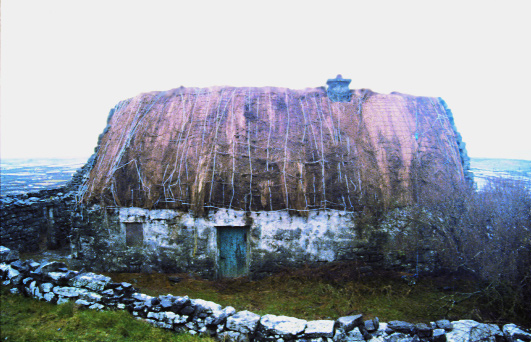
Inishmaan 1991
The ‘island of dreams’ notion hardly applies to the small islands off the north and west coasts of Ireland. These have always been what Americans would call ‘hardscrabble’ places. Island life was especially hard in the past. The unusual survival of census documents from 1821 for the Aran Islands demonstrates this clearly. They show a subsistence, peasant society where the few resources available had to be exploited to the utmost. Apart from full-time fishermen, mainly in Killeaney village, Inishmore, a number of labourers and some people, mainly widows, who made fishing nets, few people had only one recorded occupation. Sixty per cent of household heads worked the land, but most had to have other jobs, for agriculture on Aran was not an easy affair. Holdings were not that small for rural Ireland, the mean holding size for the three islands being 11.3 ha, but the land often had to be ‘made’, by creating artificial soil on the islands’ bare limestone by spreading layers of sand and seaweed onto the rock surface. Loose rocks would be crafted into the famous Aran drystone walls to protect the precious soil. Further, the farmers did not own their holdings, the islands belonged to an absentee landlord in Dublin. The secondary jobs, in addition to farming, were usually as fishermen and/or kelpmakers (kelp is seaweed which was gathered, dried and burnt to ash, from which iodine and other by-products were extracted). Kelpmaking was an important feature of the Aran economy as it produced cash, needed to meet rental payments. Further activities not recorded in the census, but known to have existed included sealing, the taking of seabirds and illicit distilling. Wrack (material washed ashore) was avidly gathered—providing wood for building or fuel, for example. Otherwise on their islands which provided neither wood nor turf, the islanders burnt bualtrach (cow dung), which would be dried on walls. In short, the Aran Islands in 1821 displayed an economy which was stretched to its utmost with every feasible activity exploited. No wonder then that in 1822 when bad weather caused the potatoes to fail, there was a crisis on the islands serious enough to require outside help.
Population decline
Such over-stressed economies were not capable of much expansion and were increasingly unable to satisfy people who, during the nineteenth and twentieth centuries, became aware of the opportunities created by industrialisation in north-east Ireland and Britain, as well as the real or mythical opportunities of faraway America. And so the islanders left—in droves. Sometimes an island proved unable to sustain a viable society at all and complete depopulation resulted. The 1841 census identified 211 inhabited islands with a total population of 38,138; in 1991 there were just sixty-six with about 9,700 people and many of these islands are now connected to the mainland by fixed links. In percentage terms, the population decline on Irish islands was minus 74.6 per cent, almost twice the rate of loss from Ireland as a whole, which was minus 37.6 per cent during this period.
This outpouring of people unwilling to put up further with the hardships of island life has left its mark, in both physical and other ways. Regarding landscapes, on the depopulated islands—Great Blasket, Finish, Scattery, Owey and scores of others—are silent, empty, largely tumbled, villages, standing in evocative echo of their lost society. Even islands still with people have empty houses, sometimes empty villages as on Dursey and Achill. Further, all the islands had to be more intensively farmed in the past to enable them to support their greater populations and abandoned fields and lazy beds are mute testimony to this past pressure.
Ruined villages and old agricultural systems are now viewed in heritage terms, the deserted Slievemore village on Achill even has a preservation society. Visitors are taken to the islands and wander round the ruined cottages trying to conjure up the ghosts of the long-gone islanders. Another way of doing this is to read the long-gone islanders’ accounts of their own lives. These works are part of the island heritage too, and might be considered as much a product of island emigration as the deserted villages, for they were written in conscious realisation that the way of life being recorded was subject to irreversible decay as migration slowly but surely destroyed their community. The most notable writers were the three Great Blasket Island autobiographers: Tomás Ó Criomhthain (1856-1937), An tOileánach [The Islandman] (1929); his great-nephew, Muiris Ó Súilleabháin (1904-1950), Fiche Blian ag Fás [Twenty Years a’Growing] (1933); and Peig Sayers (1873-1958) who married into the island in 1892, Peig (1936) and Machtnamh Seana-Mhná [An Old Woman’s Reflections (1939).
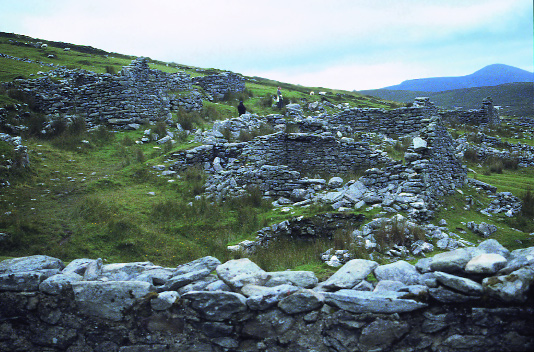
Slievemore deserted village, Achill Island, County Mayo, 1996
Tomás Ó Criomhthain
Much of Ó Criomhthain’s book details the way in which islanders earned their living: farming, fishing, trading with the mainland and ships, gathering wrack, cutting peat. His occupational pluralism—reminiscent of that revealed by the census for the Aran Islands generations before—extended to his building his own house, the ruins of which can still be seen, and on helping the Congested Districts Board build five houses on the island. An tOileánach has bleak passages, particularly those on the death of most of his children, from infection, cliff falls or drowning, but it details in a positive manner a vibrant, if always pressured, island community struggling to wrest a livelihood from an unfavourable and unforgiving environment. Ó Criomhthain consciously recorded his small world for posterity: ‘for the like of us will never be again’. Part of this change was caused by emigration. Many of his family went to America leaving Tomás, the ‘spoilt child’ to ‘keep the little house’ going for his parents. Later, a brother came back, but occasional returns did not stem the tide of emigration. One man had a houseful of children then, [but] there are only three of them in my neighbourhood now, the rest of them are in America…like so many others.
Peig Sayers
The second author by seniority, if not by publication date, was the mainland woman, Peig Sayers. She had wanted to migrate to America, following her childhood friend, Cáit-Jim. One of the most powerful scenes in Peig is an ‘American wake’, the party given to a departing migrant, the funereal element a recognition that the person would probably never be seen again. However, Cáit-Jim was unable to remit passage money to Sayers as promised, leaving her with ‘two choices in the palm of my hand—to marry or go into service again’. She chose marriage, an arranged match with Blasket man, Peats Guiheen. Her first impression of Great Blasket acts as a counterpoise to what was to come for the island seemed ‘black with people’, welcoming her to her new home. Though comforted by thought of her ‘fine handsome man’, she still hankered for America:
The blessing of God be with you, Cáit-Jim, I said in my own mind, you were the lucky one. Whatever happens your feet will be planted on mainland clay. Not so with me! How lonely I am on this island in the ocean.
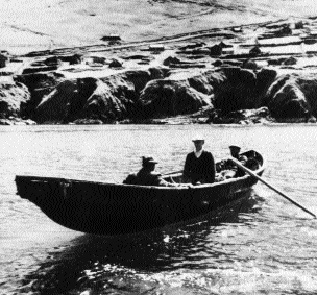
Her bounded horizons continued to fret her: ‘I think this is a very confined place with the sea out there to terrorise me’. In the last chapter, as a lonely widow, she returned to this theme:
The most of my life I’ve spent on this lonely rock in the middle of the great sea. There’s a great deal of pleasantry and hardship in the life of a person who lives on an island like this that no one knows about except one who has lived here—going to bed at night with little food and rising again at the first chirp of the sparrow, then harrowing away at the world and maybe having no life worth talking about after doing our very best.
She certainly had a life worth talking about—literally, as her autobiography was dictated—but the necessity to ‘harrow away’ is ever present in the Blasket biographies and this engendered the feelings that she had had, and so many others had acted upon, of wishing to emigrate, a constant theme throughout Peig:
‘I heard Siobhán was thinking of pulling out and going off to America’.
‘She is and her sister Cáit will be off with her. They’d rather do that than put down roots here’.
In a sad chapter entitled ‘Scattering and sorrow’ she loses a son, Tomás, to a cliff fall and ‘six months after this my son Pádraig hoisted his sail and went off to America’, it having been remarked by Tomás on the morning of his death that ‘isn’t it time he [Pádraig] went’, migration being an accepted stage in Blasket life. Another son, Muiris, was
deeply attached to his country and to his native language and he never had any desire to leave Ireland. But that’s not the way events turned out for he, too, had to take the road like the others, his heart laden with sorrow. As soon as he had turned the last sod on his father’s grave he made ready to go. The day he went will remain forever in my memory because beyond all I had endured, nothing ever dealt me as crushing a blow as that day’s parting with Muiris.
Nonetheless, her response to Muiris’s intention to leave was: ‘’Twould be a bad place that wouldn’t be better for you than this dreadful rock’. Her other children also departed and Sayers was left ‘desolate’, alone with only her dead husband’s blind brother, a ‘feeble old man’, for company. Thus, when one son, not Muiris but Micheál, returns because of the ‘hardship of the world’, if ‘he was sad, I was delighted’.
Like Ó Criomhthain, Sayers was conscious of change: ‘I suppose that never again will there be an old woman as Irish as me on this island’. Further, in Machtnamh Seana-Mhná, she concludes that ‘the little house where she used to eat and drink, it’s unlikely there’ll be a trace of it there’. Actually her house, one of those on which Ó Criomhthain had worked, not only remains but still has a roof, unlike those of the other two authors. By contrast, her foreboding certainly came true regarding the people on her ‘beautiful little place, sun of my life’, for she must have been one of those evacuated from the island, a few years before her death in 1958.
Muiris Ó Súilleabhain
Sayers reminisced, sometimes bitterly, from the standpoint of old age, as emphasised by the title of her second book. In contrast, Ó Súilleabhain, using the words of ‘Daddo’, his grandfather who had told him that ‘the life of man’ was ‘twenty years a-growing, twenty years in blossom, twenty years a-stooping and twenty years declining’ focused on himself a-growing. His book is much lighter in tone, but still has many sad references to emigration. He, himself was an emigrant, leaving the island in early blossom. He was drowned in his mid-forties, just into his a-stooping. He wrote of hunting seals and birds and mentioned having livestock, but his principal employment was in fishing. However,
the chief livelihood—that’s the fishing—is gone underfoot, and when the fishing is gone underfoot, the Blasket is gone underfoot, for all the boys and girls who have any vigour in them will go over the sea…And what will our parents do when they grow old? It is my opinion that they will have to do without us.
One chapter is devoted to the American wake of Ó Súilleabhain’s sister, Maura, off to Springfield: ‘God help the old people, there will be none to bury them’, says their father who remembered when there was ‘no thought of America…and they were fine, happy days’. Maybe so, but they were days past, for Maura retorted ‘don’t you see everyone is going now and you will see me beyond like the rest of them’. Thus
a great change was coming on the island…all the young people were departing across to America, five or six of them every year…there was nobody left in the house but my grandfather, my father and myself.
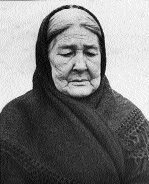
The three Great Blasket Island autobiographers, Peig Sayers,Tomás í“ Criomhthain, and Muiris í“ Síºilleabhain (Thomas Mason; TCD Synge collection; Dept. of Irish Folklore, UCD)
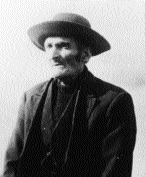
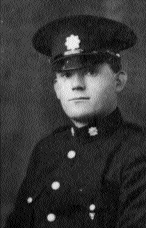
Ó Súilleabháin did stay, not going to America, instead to Dublin, to join the guards. The book ends with his first visit back to Great Blasket after two years. His content at seeing his father and Daddo either side of the fireplace is contrasted to the changes wrought by emigration on his island:
green grass was growing on the paths for lack of walking, five or six houses were shut up and the people gone out to the mainland; fields which had once had fine stone walls around them left to ruin; the big red patches on the sandhills made by the feet of the boys and girls dancing—there was not a trace of them now.
Today the footprints of the ‘children of one mother’ as Ó Súilleabháin called the people raised so closely together, tread different paths and the last child born to the one mother is becoming elderly. There are paths on Great Blasket again, but they are trodden by the feet of strangers, trippers walking round the ruined village and stepping into the houses of Ó Criomhthain, Sayers and Ó Súilleabhain which are marked out for them. Some have left messages in a comments book; one with a Springfield address that she ‘was glad to see my grandfather’s home’.
The Blasket story is celebrated by taking people to visit the island itself, boats run there from Dunquin. Further, there is the new Blasket Heritage Centre that stands on the mainland overlooking the island, a splendid tribute to the Blasket heritage. However, the heritage celebrated there is dead. Elsewhere, efforts are being made to try and end the scourge of migration that turned so many island communities into history. Many islands have co-operatives to try and maximise their productive economy; the islands are eligible for grant aid in many ways, from local and national government and the European Union, to try and build up their facilities and opportunities; there is an effective island pressure group, Comhdháil Oileán na hÉireann, which strives to improve conditions on the islands; and there is now an Irish government committee, the Interdepartmental Co-ordinating Committee on Island Development to oversee island matters whose strategic plan of 1996 starts with this mission statement:
To support island communities in their economic, social and cultural development, to preserve and enhance their unique cultural and linguistic heritage and to enable the islanders to secure access to adequate levels of public services so as to facilitate full and active participation in the overall economic and social life of the nation.
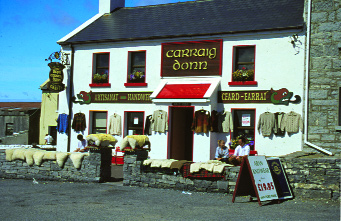
Tourism-the modern economy of Inishmore, County Galway, 1997.
Out-migration has not yet turned all the Irish islands into outdoor museums, and with such strong support, maybe there is hope for the future after all.
Stephen Royle lectures in geography at Queen’s University, Belafast.
Further reading:
S. Royle, ‘From the periphery of the periphery: historical, cultural and literary perspectives on emigration from the minor islands of Ireland’, in R. King and J. Connell (eds.) Small Worlds, Global Lives: islands and migration (London 1998).
M. Cross, ‘Service availability and development among Ireland’s island communities: the implications for population stability’, in Irish Geography, 29.1, 1996.
S. Royle and D. Scott, ‘Accessibility and the Irish islands’, Geography, 81.2.
M. Mac Conghail, The Blaskets: people and literature (Dublin 1987).
















